Belvidere
Houses within 15km of this house
Displaying 118 houses.
Houses within 15km of Belvidere
Displaying 118 houses.
| House name | Description | |
|---|---|---|
| Aghern/Ahern House | Brabazon Esq was resident in the 1770s and 1780s. The home of Spotswood Bowles in the first half of the 19th century. The buildings were valued at £47+ in the early 1850s and held from the representatives of William Beamish. Spotswood died in 1864 and was succeeded by his son George who was in turn succeeded by his nephew Spotswood in 1886. Relatives of the Bowles owned this property until the 1970s. In 1942 the Irish Tourist Association Survey mentions the ruins of Aghern Castle in the grounds of Mrs. Spotswood Bowles property. Aghern was uninhabited for a time but has recently been restored. |

|
| Kilbarry (Castlelyons) | Hajba writes that a new house was built here in 1842 by the Wigmores. Robert Wigmore was resident in 1814, E[dward] Wigmore in 1837 and Henry Wigmore in the early 1850s when the buildings were valued at £23 and held in fee. In 1786, Wilson states that it was the residence of Hon. Mr. Moore. Later the home of the Kent and Waters families. Still extant and occupied. |

|
| Ballyglass/Ballyclough House | At the time of Griffith's Valuation Michael Cagney owned a house in the townland of Kilmagner valued at £24. Ballyglass House is marked on the first Ordnance Survey map in this townland. but the house at this location is named Ballyclough House on the 25-inch Ordnance map of the 1890s. Hajba identifies this house as Ballyclough House, Currabeha. Ballyclough was the residence of E. Creed in 1837. A house still exists at this location. | |
| Bellevue | Hajba writes that William Glissan sold this property to Thomas Dennehy of Clashmore, county Waterford. Bellevue was the home of Thomas Denehy in the first half of the 19th century, inhabited by him in 1814 and 1837 and by Daniel O'Neill in the early 1850s who held it from Thomas Denehy. The house was valued at £35. Later the home of the Dunleas, now a ruin. |
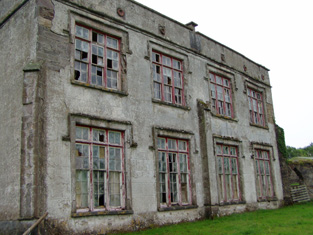
|
| Brook Lodge | The Lord Chancellor is given as the occupier of this house at the time of Griffith's Valuation. The Court of Chancery may have held the property from John Denehy at this time. The buildings were valued at £13. In 1942 the Irish Tourist Association Survey notes that it was once the residence of General Sir Thomas Dennehy and was then owned and occupied by James Scannell. A new house is now located on the site. | |
| Bettyville | The home of the Nason family in the early 19th century, occupied by Richard Nason in 1814 and 1837. By the early 1850s William Corbin was resident holding the house valued at £14.10 shillings from the representatives of Richard Nason. William Corbin was still living at Bettyville in the 1870s. This house is no longer in existence. | |
| Careysville | Careysville Castle, originally known as Ballymacpatrick Castle, was the seat of the Carey family from the late 17th century. In 1750 Careysville was occupied by John Carey and Peter Carey was resident in 1814. In 1837 Lewis refers to “the handsome modern mansion built on the site of Careysville castle” by E.K. Carey. Valued at £50 in the mid 19th century the Careys held this property in fee. Inherited by the Montgomerys of Killee and sold by them to the Duke of Devonshire in the mid 20th century. In 1942 the Irish Tourist Association Survey noted that the house was then unoccupied as Captain Montgomery had moved into a modern bungalow nearby. Careysville is now in use as a fishing lodge offering luxury accommodation. |

|
| Moorepark | A large Georgian house, the seat of the Earls of Mountcashell, extended in the 19th century. In 1786 Wilson describes it as "a superb and noble seat". It was held in fee at the time of Griffith's Valuation when it was valued at £87. Bought by the War Department in 1903 and accidentally burnt in 1908. In 1944 the Irish Tourist Association Survey noted that the remains of the kitchen were still visible then. Nothing remains of the original house and the site now belongs to Teagasc, the Agricultural and Food Development Authority. | |
| Glandulane House | Robert Briscoe had a house and flour mill in the townland of Clondulane North in the mid 19th century, which he held from the Earl of Mountcashel. The house was valued at £25.10 shillings and a flour mill at £96. Later the home of the Hallinans and the O'Donnells. A house is still extant at the site but the mill buildings are now ruinous. |

|
| Mountrivers | This house was a Hendley home in the 18th and 19th centuries, occupied by Mathers Hendley in 1814 and Mattias Hendley in 1837. Mattias C. Hendley was resident in the early 1850s. He held the property in fee and the buildings were valued at £27. The Hendleys contined to reside at Mountrivers until the 1930s and the house is still occupied. |
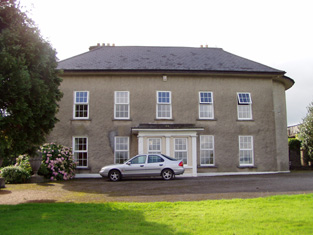
|
| Douglas House | Occupied by Henry Deece in 1837 and by Lady Mountcashell in the early 1850s. Held from the Earl of Mountcashel and valued at £16.10 shillings. Later the home of the Magniers and still a residence. |
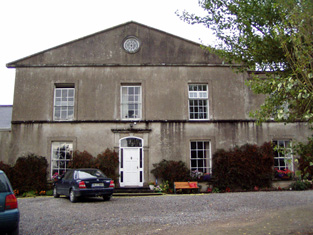
|
| Park House | Hajba writes that David Richard Pigot, Chief Baron of Ireland 1846-1873, was born at Park House in 1797. He was the son of Dr John Pigot and Margaret Nagle and married Catherine Paye [Page in DNB] of the nearby Araglin Mills. Th house was valued at £7.10 shillings in the early 1850s and was occupied by the Reverend James Daly, who held it from William Byrne. The Pigotts continued to own this property until at least the late 19th century. Occupied by the Howard family in the 20th century. The Irish Tourist Association Survey notes that it was also referred to as "Rock House". The survey also refers to another house owned by the Pigot family on the main street in Kilworth. | |
| Moydilliga/Modeligo | In the mid 19th century this house was the home of Henry Braddell. It was valued at £16 and held by him in perpetuity. Wilson, writing in 1786, refers to it as the seat of Mr. Armstead. By 1906 the mansion house at Moydilliga was valued at £42 and occupied by Henry Braddell. In the early 20th century the property passed to the Haskins-Braddells. Sold by them in 1950, this house is still a family home. |
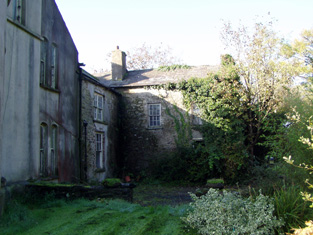
|
| Kilmurry | The house was built in the early 18th century and remained in the hands of the Grant family until sold to the Rosminian Order in the 1930s. In the 1940s the Irish Tourist Association surveyor was given to understand that the Grants still retained title to the property and were residing in South Africa. In the mid 19th century it was valued at £37 and held by Thomas St John Grant in fee. At the beginning of the 21st century this house was in a dilapidated state. |
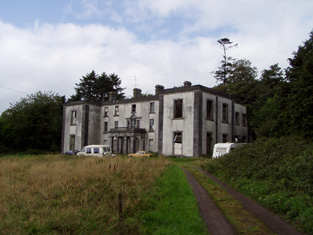
|
| Knockatrasnane | At the time of Griffith's Valuaiton, William Collis held in fee a house and offices valued at £14.10 shillings in this townland. The 1st edition Ordnance Survey map indicates a nursery at this site. The remains of the buildings are still extant. | |
| Castle Cooke | A house was located here from the 17th century. Originally home of the Cooke family it was altered and expanded in the succeeding centuries by the Collis family. William Collis was resident for much of the 19th century. The house was valued at £32 in the early 1850s and at £34 when occupied by Colonel William Cooke Collis in 1906. It was burnt in June 1921 during the War of Independence when it was the residence of Col. William Cooke-Collis. This house is no longer extant. | |
| Leitrim | Home of the Campion family for two centuries, sold by them in the 1870s to Major Victor Reeves of the Castle Kevin family. In 1943 the Irish Tourist Association Survey referred to it as the residence of David Nunan, formerly owned by the Campions, "in their day the house was thatched and much smaller". This 17th century house is still a residence. |

|
| Marshtown/Marston | Home of Richard Henry Gumbleton in the early 19th century and at the time of Griffith's Valuation when the buildings were valued at £12. 10 shillings. Advertised for sale in June 1854. Hajba writes that the Orpens built a much large house on the demesne in the 1860s which was burnt some time later. In 1906 Basil Orpin occupied a house valued at £55 at Marshtown. Buildings still exist at this site. An earlier Marshtown House, previous home of the Gumbletons, was located over the border in county Waterford. | |
| Araglin Cottage | Located on the bank of the Araglin River and built for Robert Viscount Kingsborough, later 4th Earl of Kingston, this was probably the summer residence recently erected by the Honourable Robert King in the parish of Templemologga, referred to by Lewis in 1837. It was offered for sale in July 1851 with 3,951 acres held by the Earl in the barony of Condons and Clangibbon. Sold to the Morlands who leased it as a fishing lodge, this house is now a family home. In the 1870s John Sherlock of Aroglin Cottage, Kilworth, was recorded as the owner of 183 acres in county Cork. |

|
| Ballyvolane | Hajba writes that Ballyvolane was bought by Sir Richard Pyne of Waterpark, Lord Chief Justice of Ireland, from the Coppingers in the early 18th century. It remained in the possession of the Pyne family until the mid 20th century and is still occcupied. Valued at £44 at the time of Griffith's Valuation, the house was occupied by Jasper Pine who held it from Thomas, George and Henry Walker. By 1906 the mansion house at Ballyvolane was valued at £70+ and occupied by George M.Pyne. |

|
| Ballyrobert | Hajba writes that Michael Mackay built a house beside the ruined castle of Ballyrobert in the 1820s and he is recorded as resident there by Lewis in 1837. In the early 1850s the house was valued at £23, occupied by Michael Mackay and held from John Peard. Michael J. Mackey occupied the house in 1906. This house no longer exists. | |
| Coole Abbey | This house was the home of a branch of the Peard family until the early 20th century and is still inhabited. It was occupied by Richard Peard in 1814 and by Henry Hawk Peard in 1837. He was still resident in the early 1850s and held the house valued at £36 from James H. Smith Barry. By the end of the 19th century Orr McCausland was the owner of Coole Abbey. |
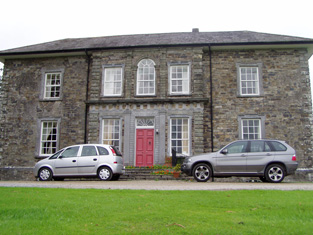
|
| Carrigeen Hall | In 1786, Wilson refers to "Carrygeen" as the seat of Mr. Peard. Hajba writes that this house was the home of Peard Harrison Peard, son of Richard Peard of Coole Abbey and father of Richard Frederick Peard of Belvidere and Henry Peard of Carrigeen. Later the home of the Green and O'Grady families, now demolished. | |
| Sun Lodge | Sun Lodge is marked on the first Ordnance Survey map and was occupied by Denis Hanan in the mid 19th century and held from Henry Peard. It was valued at £30+. Hanan's interest was advertised for sale in 1870. Hajba records various other occupants and this house is still occupied and well maintained. |

|
| Castleview | Castleview was the home of the Gumbleton family held from Henry Peard in the mid 19th century and valued at £68.15 shillings. The house remained in Gumbleton possession until the early 20th century but is now demolished. Bence Jones lists this house under the name Glynnatore and writes that it was built in 1791 by R. W. Gumbleton. In 1894 Slater notes Glenatore as the seat of Mrs. Gumbleton. | |
| Waterpark | Originally a Pyne residence which later passed through marriage to the Cavendishes. In 1786 Wlson refers to "the ruins of Water Park, the seat of the late Lord Chief Justice Pine". Hajba writes that other occupants were the Watkins and Drew families. There was no house of more than £2.10 shillings valuation in this townland, held by George Walker, at the time of Griffith's Valuation. | |
| Kilcor Castle | The home of the O'Brien family in the 18th and 19th centuries, sold by them in the mid 19th century. Cornelius O'Brien was the occupant in 1837 and at the time of Griffith's Valuation. He held the house valued at £17.15 shillings from James Reid. Kilcor was bought by Francis Doyne Dwyer and later passed to the Phipps family through marriage. In the 1940s the Irish Tourist Association Survey reported that it was the residence of Captain H. Phipps. |
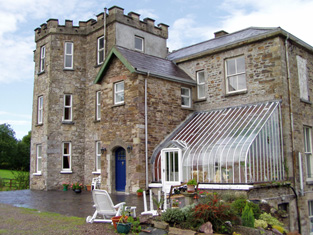
|
| Mohera | Hajba writes that Michael Mackay was recorded as resident here in 1824. By 1837 John O'Sullivan was resident and was still the occupier at the time of Griffith's Valuation. The buildings were then valued at £14 and the property was held from Major General Conyers. Home of the McAuliffes in the 20th century. |

|
| Rathbarry Cottage | Rathbarry Cottage was occupied by Major William Love Peard at the time of Griffith's Valuation. The property was held from the Reverend R. Gumbleton and the buildings were valued at £11. Some ruined walls remain at the site. | |
| Towermore | The home of Mrs Maria Oliver in 1837 but leased to Frederick C. Hayes in the early 1850s. The house was valued at £45. Maria was the widow of Charles S. Oliver of Inchera and a daughter of A. Morris of Dunkettle. A. Morris Oliver is recorded as a subscriber to Lewis ''Topographical Dictionary'' published in 1837 but is not mentioned in Burkes. Earlier, in 1786, Wilson refers to Tormore as the seat of Mr. Connor. This house was not occupied at the end of the 20th century although still extant. | |
| High Park | Occupied by the Reverend J. W. Edgar in 1837 and by Bridget Hogan in the mid 19th century, valued at £12+ and held from William Coppinger. This house no longer exists. | |
| Mellefontstown | The main residence of the Nason family in the 18th century, John Nason was resident in 1814 and Pierce Cotter in the early 1850s. Cotter held the property from Thomas Wise and the buildings were valued at £19+. In May 1863 Pierce Joseph Cotter's estate at Mellifontstown, containing the house, demesne and 246 acres was advertised for sale. It was held on a lease dated 1852 from Francis Wise to Pierce Cotter for 185 years. A new house now stands on the site. | |
| Newtown | Newtown House was inherited by the Nasons through marriage with a Harrison heiress in 1716. It continued to be the main seat of one branch of the Nason family until the end of the 19th century. Still in Nason occupation in 1906 when the buildings were valued at £13. Only some ruined walls now remain. | |
| Newtown Lodge | Another Nason residence, occupied by Henry Nason in the mid 19th century and held from John Nason, the buildings were valued at £21. It remained in Nason possession until the early 20th century. This house is still a family residence. |
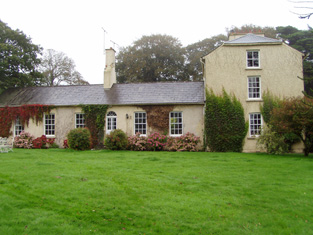
|
| Mount Prospect | A Bowles family home, occupied by George Bowles third son of Robert Bowles of Springfield and father of Spotswood Bowles of Ahern. George was resident in 1814 and his widow was living there in 1837. His son George was resident at the time of Griffith's Valuation holding the property from Minor Cormack. The buildings were valued at £28+. Later the residence of Lieutenant Colonel George Eyre Massy [son of Hugh]. |

|
| Ballymacsimon | A house located on the Devonshire estate and occupied by John Kirby in the mid 19th century. The buildings were valued at £25. William Kirby held 2 townlands in the parish of Aghera at the time of Griffith's Valuation. Home of the Collins family in the mid 20th century and still inhabited. | |
| Booladurragha South | William O'Neill was occupying a house in this townland at the time of Griffith's Valuation, the buildings were valued at £15+ and the property was held from the Duke of Devonshire. The Duke is given as the occupier of this house in 1906. A house still exists at this site. Boulta House now functions as a guest house. |
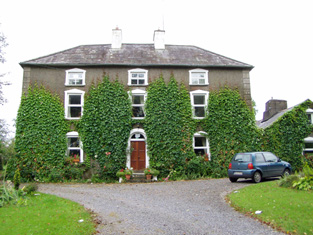
|
| Bride Park | Hajba writes that the Reverend Stephen Rolleston built this house in the 1770s. In 1814 it was inhabited by the Reverend Spread and in the mid 19th century by Thomas Power who held it from Mrs Elina Greaves and others. The buildings were valued at £20+. Bride Park remained the home of the Power family until the early 20th century. This house has recently been renovated and restored. |

|
| Carrigmore | Richard Power was resident here in 1814 and Edward Morragh in the mid 19th century. Morragh held the property from the Duke of Devonshire and the buildings were valued at £18+. Later the home of the Cronin family. Hajba writes that this house has been unoccupied since 1990. | |
| Thornhill | A Nason home, first occupied by John William Washington Nason. His widow Mrs Barbara Nason is recorded as resident at the time of Griffith's Valuation. Valued at £18.11 shillings the house was held from the Duke of Devonshire. The Nason family continued to live here until the mid 20th century. The house is still an occupied residence. | |
| Killavarilly | At the time of Griffith's Valuation John O'Neill, a doctor, held a house valued at £25+ and 350 acres from the Duke of Devonshire at Killavarilly. A house is still located at this site. | |
| Lisnabrin | A 3 storey 18th century house built by the Crokers on property inherited through marriage with the Coppingers in the 17th century. In the mid 19th century occupied by Edward Croker junior, son of Walter, the house was valued at £33+ in the early 1850s. Edward Croker died in 1901and Letitia C.C. Croker is recorded as the occupier in 1906. The property later passed to a relative Captain Walter A. Carew. The house was a hotel for a short time in the mid 20th century but is once more a family home. |

|
| Kilmacow | Located on the Devonshire estate, on the Cork/Waterford border, Kilmacow was occupied by John Boyce in 1814 and by William John Day in the early 1850s. The buildings were valued at £12. Bought by John Murphy of Tallow in the late 19th century and still extant. |
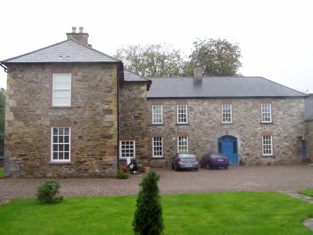
|
| Mogeely House | A house on the Devonshire estate, occupied by Charles H. Walsh in the mid 19th century and valued at £25.18 shillings. Later the home of the Des Barres and Kent families. Slater refers to it as the seat of Lt-Col. Des Barres in 1894. Still a family residence. It is labelled Mogeely Castle on the 1st edition Ordnance Survey map but as Mogeely House on the later editions, |
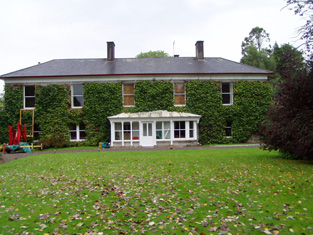
|
| Lisnabrin Lodge | Occupied by Thomas Carew in 1837 and by Sands Bellis who held the house and 28 acres from Thomas Carew in the mid 19th century. The buildings were valued at £36+. This house is extant, occupied and well maintained. |

|
| Curraglass House | Part of the Lysaght estate from the mid 18th century, W. and L. Giles are recorded at Curraglass in 1814. Earlier, in 1786, Wilson refers to it as the seat of Mr. Bonwell. By 1837 W. Gumbleton was resident and his widow Mrs Georgina Gumbleton occupied the house in the early 1850s. It was valued at £58+. Hajba writes that she was the last occupant of the house which is now demolished. | |
| Frankfort | This was a Woodley home, occupied by F. Woodley in 1837 and leased to Robert Wigmore in the early 1850s when the house was valued at £20+. The house was occupied until the 1970s but is now a ruin. |

|
| Templevally | The home of the O'Mahony family in the 19th century, occupied by William O'Mahoney at the time of Griffith's Valuation, valued at £26+ and held from Cooper Penrose. Late this house was home to the Condons. The original house is demolished and a later house is now inhabited. |
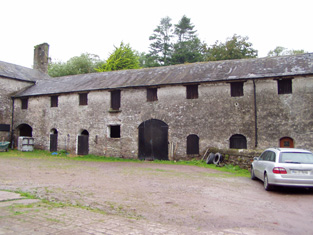
|
| Woodview | Woodview was the home of the Reverend George Nason in 1837 and in the early 1850s was occupied by his son Charles Nason who held the property from Major Edward Croker [Lisfinny]. The buildings were valued at £13+. This house is still a family residence. | |
| Clonmult | The Powers appear to be associated with Clonmult from the late 17th century. In the first half of the 19th century Pierce Power was resident, the house being valued at £23 in the early 1850s and held from Edward Phayre. A Shaw Smith home in the second half of the 19th century. Louis K. Smyth is recorded as the occupant in 1906 when the buildings were valued at £16. 15 shillings. |
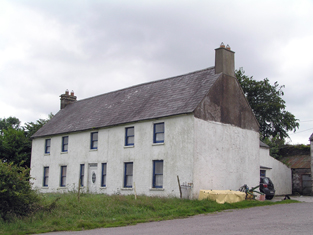
|
| Breeda House | Roger G. Davis held a house in fee, valued at £17, in this townland at the time of Griffith's Valuation. Breeda House is labelled on the 25-inch Ordnance Survey map of the 1890s. A house is still extant at the site. | |
| Mount Uniacke | A home of the Uniacke family in the 18th and 19th centuries, occupied by three generations of persons named Norman Uniacke in the 19th century. Earlier, in 1786, Wilson refers to it as the seat of James Uniacke. In the mid 19th century it was held by Norman Uniacke in fee and the house was valued at £30. The Irish Tourist Association Survey of the 1940s reported that it had been burnt in 1921 and it is no longer extant. | |
| Lismore Castle | The castle belonged to Sir Walter Raleigh who sold the property to Sir Richard Boyle in 1602. Charlotte Elizabeth Boyle, the daughter and heiress of the 4th Earl of Cork, married William Spencer Cavendish, 4th Duke of Devonshire and when she died in 1754 the estate passed to the Cavendish family. At the time of Griffith's Valuation, the castle was valued at £140. The 1943 ITA survey contains an extensive description of the castle and its grounds at that time. It has remained in the hands of the Cavendish (Devonshire) estate, housing a prestigous art gallery. See www.lismorecastle.com. |

|
| Ballyre | This house was occupied by Crofton Uniacke at the time of Griffith's Valuation when it was valued at £29.15 shillings and held from Mountifort Longfield. Earlier, in 1786, Wilson refers to it as the seat of Crofton Uniacke. The home of Robert M. Bayly in the 1870s. It is still extant. |
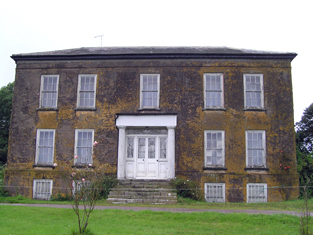
|
| Glengarra | Occupied by Robert Dring in the early 1850s, valued at £25 and held from Robert Uniacke. Still extant and occupied. |
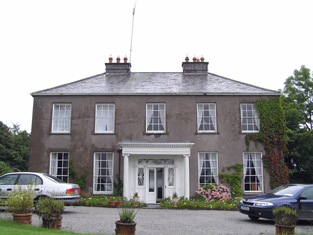
|
| Castletown | The home of James Uniache in 1814 and of Norman Uniacke in 1837. Robert Uniacke held the property in fee at the time of Griffith's Valuation when it was valued at £20. In 1786 Wilson also refers to it as the seat of James Uniacke. This house was a ruin at the beginning of the 21st century but the National Inventory of Architectural Heritage refers to its restoration. |
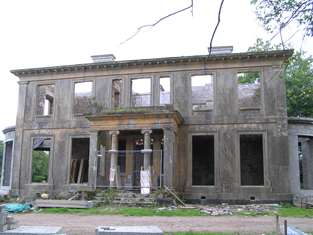
|
| Castlelyons House | Situated on 2 acres in the centre of the town of Castlelyons this house was in the possession of the related clerical families of Browne and Ryder in the 18th and 19th centuries. Occupied by the Reverend Joshua B. Ryder in the mid 19th century. He held the property valued at £30 from Samuel Perrott. Still valued at £30 this house was occupied by the representatives of Andrew W. Ryder in 1906. |

|
| Berry Hill | The National Inventory of Architectural Heritage states that this house dating from circa 1700 was a dower house for the Barrymore family of Castlelyons Castle. By the mid 19th century it was in the possession of the Perrott family and occupied by the Reverend Philip Berry who held the buildings valued at £21 with 15 acres. This house is still occupied. |
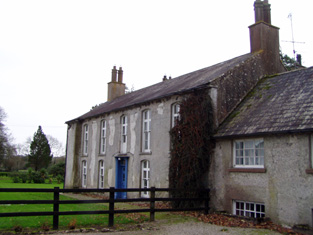
|
| Monaloo | This house was built post Griffith's Valuation. In the 1870s Charles Nason of Monaloo House, Tallow, owned 797 acres in county Cork. It is still extant. |

|
| Strancally Castle | John Keily held Strancally Castle in fee at the time of Griffith's Valuation, when it was valued at £61. Lewis refers to it as "a modern castle, seat of J. Keily" in 1837. There is a lithograph and extensive description of the castle and demesne in the sale notice of 1856. After this the castle came into the ownership of the Whitelock Lloyd family. In 1906 it owned by George W. Lloyd and valued at over £63. The 1943 ITA Survey provides a detailed description of the house from that time including the art collection and library. It is still extant and has been renovated in recent years. An extensive farmyard, valued at £37 in 1851, is located in Kilmanicholas townland at X078903. This property was valued at over £40 in 1906. |
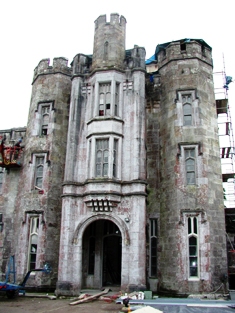
|
| Knockanore House | Rev. Thomas Queally was leasing a property at Knockanore valued at £10 10s from the Keily estate in 1851. It is not shown on the 6-inch Ordnance Survey Map but is labelled Knockanore House on the 25-inch map of the 1890s. The property appears to have fallen into disuse during the twentieth century. | |
| Ballyhamlet House | James Parker was leasing Ballyhamlet from the Earl of Shannon's estate in 1851 when it was valued at £17. There is still an extant house at the site. | |
| Headborough | At the time of Griffith's Valuation, Headborough was held in fee by Mrs. Catherine Smith [Smyth] and valued at £60. Lewis refers to it as the seat of Rev. Percy Scott Smyth in 1837. In 1906 it was owned by Percy Smyth with a valuation of £50. Smith mentions Headborough as the seat of William Smith. In 1943 the ITA survey notes that the stone used in its building was transported from county Kerry. It is still extant and occupied. |

|
| Janeville (County Waterford) | Janewille House was vacant at the time of Griffith's Valuation, when it was part of the Ussher estate and valued at £22 10s. A second house [X027936] in the same location was leased by Henry Smyth from the Ussher estate and valued at £15 10s. In 1837 Lewis refers to Janeville as the seat of A. Keily. Wilson, writing in 1786, refers to it as the seat of John Keily. The house is no longer extant. | |
| Moorehill | Held in fee by William Moore at the time of Griffith's Valuation, when it was valued at £55. Lewis also refers to it as his seat in 1837. Wilson, writing in 1786, notes it a the seat of Rev. Mr. Moore. In 1894 and 1906 it was the property of Captain William Perceval Maxwell and valued at over £70. In 1943 the ITA survey noted it as the residence of Captain Maxwell and mentioned that it was an eighteenth century house. It is still extant and occupied. | |
| Sapperton House | Held in fee by the Moore estate at the time of Griffith's Valuation, when it was valued at £37. It is described as a farm-house. Lewis refers to it as the seat of S. Moore in 1837. Wilson, writing in 1786, notes Sapperton as the seat of Major Moore. It was inherited by Willam Percival Maxwell. In 1906 he was the owner and the house was valued at £37. Sapperton, as well as its extensive farmyard, is still extant and occupied. |
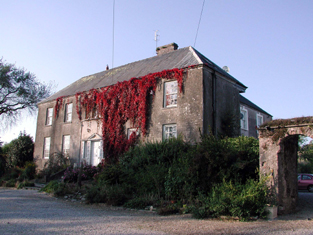
|
| Snugborough | In 1786 Wlson refers to Snugborough as the seat of Mr Smith. Mrs. Helena Greaves was leasing this property to Richard Walsh in 1851 when it was valued at £10 10s. An extensive farmyard complex still survives at the site. |

|
| Ballymartin House | Francis Campion, MD, was leasing this property from the Cavendish estate in 1851 when it was valued at £16. It is present but not named on the 1st edition Ordnance Survey Map but is named Ballymartin House on the later 25-inch map. Brady indicates that the present house is of early nineteenth century date. It is still extant and occupied. |

|
| Ballinanchor House | Ballinanchor was owned by Thomas Foley in 1851 when it was vacant and valued at £12. In 1814, Leet refers to it as the residence of Captain Thomas Poole. A house and farm still exist at the site. | |
| Ballygally House | Ballygally House was the property of Nelson T. Foley in 1851 when it was vacant and valued at £27 10s. In 1837 Lewis refers to it as "the occasional residence of G. Holmes Jackson". It is still extant and occupied. |

|
| Ballyin House | In 1851 Ballyin House was held in fee by the Devonshire estate when it was valued at £22. Lewis refers to it as the residence of P. Foley in 1837. Smith refers to Ballyin as the seat of Richard Musgrave. The house is still extant and occupied. |

|
| Ballyin Flour Mill | In 1851, Nelson T. Foley was leasing this property, including a substantial flour mill. from the Devonshire estate when it was valued at £110. The mill building is now derelict. |

|
| Flowerhill House (Waterford) | Flowerhill was leased by Nelson T. Foley to Barry Drew in 1851. Lewis also refers to it as the seat of B. Drew, describing it as " a beautiful residence in the cottage style". The house is no longer extant. | |
| Toortane House | In 1851 Thomas Foley was leasing this property from the Devonshire estate when it was valued at £33 10s. Lewis refers to it as his seat in 1837. It is still extant and occupied, having been restored. |

|
| Ashbourne House | In 1851 Edmond Foley was leasing this property from the Devonshire estate when it was valued at £21 10s. It is labelled Ashbourne House on the later 25-inch Ordnance Survey Map. | |
| Elgin Cottage | In 1851 this property was leased by Georgiana Gumbleton to Edmund Barry when it was valued at £10. It was built after the 1st edition Ordnance map and is labelled Elgin Cottage on the 25-inch edition of the 1890s. There is still an extant house at the site. | |
| Marshtown House | Held in fee by R.H. Gumbleton at the time of Griffith's Valuation, when it was valued at £8 10s. The property is labelled Marshtown House on the 1st editon Ordnance Map but is not labelled on the later 25-inch edition. Marston House (W950987), in the adjacent townland of Marshtown, is shown on the 25-inch map of the 1890s but there is no trace remaining. | |
| Cloonbeg | A property described as offices, the property of R.H. Gumbleton, was valued at £15 5s at the time of Griffith's Valuation. In 1906 this property was owned by Basil Orpin with a valuation of £16. Some of the buildings still remain at the site. | |
| Fortwilliam House (Waterford) | In 1851 J.B. Gumbleton held this property in fee when it was valued at £47 10s. Lewis also refers to it as his seat in 1837 when he describes it as " a handsome demesne with a new house being erected". The ITA survey noted it as the residence of Mr. P. Dunne in 1942. Fortwilliam is still extant and occupied. In 2024 it was offered for sale. |
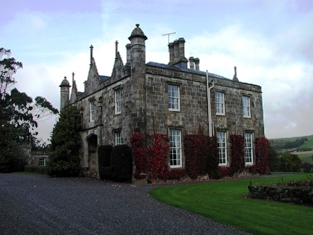
|
| Ballyduff Castle Farm | Described as Ballyduff Castle (in ruins) on the 1st edition Ordnance Survey map, these buildings were valued at £11 15s at the time of Griffith's Valuation. They were being leased by Edward Walsh from the Musgrave estate. The National Inventory of Architectural Heritage suggests the house was built c.1825. The ruined fortified house at the site dates from the early seventeenth century. |
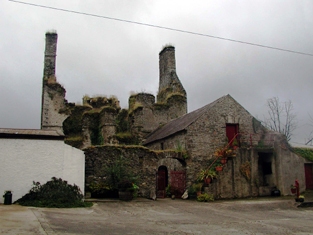
|
| Tourin and Tourin Castle | Tourin House was owned by Sir Richard Musgrave at the time of Griffith's Valuation, when it was valued at £41 10s. An earlier house, attached to Tourin Castle, is located nearby [X095965]. In 1850 it was valued at £49. In 1837, Lewis refers to this earlier Tourin House as the seat of Sir R. Musgrave, "composed partly of an ancient castle, commanding extensive and picturesque views".In 1906 the larger house had a valuation of £64 while the other buildings were valued at almost £10. The Musgrave estate still owned the properties. The ITA survey of the 1940s noted "Toureen" as the resident of Captain Jamison, formerly the property of the Musgraves. Both houses are still extant and occupied. |
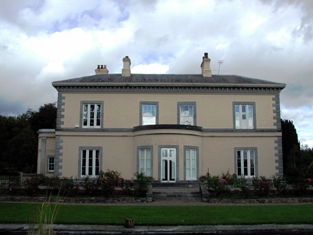
|
| Tourin Castle Farm | This property, valued at £3 in 1851, represents the original Musgrave property and attached to the ruins of Tourin fortified house. Smith refers to a castle at Tourin, owned by John Reeves Nettles and formerly in the hands of the Roches. |
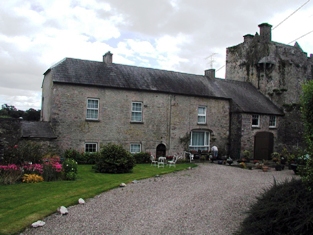
|
| Glenmore House (Lismore) | At the time of Griffith's Valuation, Thomas Boyce was leasing this property to Richard Cliffe, when it was valued at £24. A very substantial farmyard is labelled at this site on the 1st edition Ordnance Survey Map. It is labelled Glenmore House on the later 25-inch edition. It is still extant and occupied. |
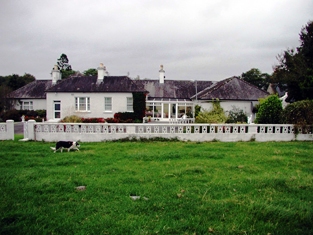
|
| Head View | John Baldwin was leasing this property from the Devonshire estate in 1851 when it was valued at £12. The National Inventory of Architectural heritage suggests it was extended during the later nineteenth century. It is still extant and occupied. In 2010 it was offered for sale. |

|
| Ballyrafter House | Francis Quinlan, MD, was occupying Ballyrafter at the time of Griffith's Valuation, when it was valued at £23 and leased from the Devonshire estate. In 1837 Lewis refers to it as the seat of M. Quinlan. It is now the Ballyrafter House Hotel. See www.waterfordhotel.com |

|
| Ballygalane House | Nicholas P. O'Gorman was leasing an unnamed property valued at £14 from the Devonshire estate in 1851. On the later 25-inch Ordnance Survey Map it is labelled Ballygalane House. Brady notes that Smith had referred to it being owned by the Crotty family. An extant house still exists at the site. | |
| Ballysaggartmore House | Held in fee by Arthur Ussher at the time of Griffith's Valuation, when it was valued at £68. Lewis refers to it as the seat of A Keily in 1837 when he describes the demesne as "ample and tastefully planned". Local sources suggest Arthur Keily-Ussher commenced building a lavish castle in 1850. The extravagent entrance depleted his funds and the castle was never completed. It was later purchased by the Woodruffe family. In 1906 it was the property of Richard Woodroffe and valued at £68. The house was burned in 1922 and demolished in the 1930s. The elaborate towers are still extant and part of the demesne is a Forestry Service amenity area. |
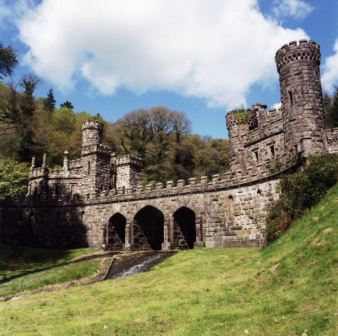
|
| Camphire House | Held in fee by Christopher Ussher in 1851 when it was valued at £28. It was the residence of Christopher M. Ussher in the 1870s. Buildings at this location were in the possession of the Ussher family in 1906 and valued at almost £6. In the 1940s the ITA survey noted that it was occupied by Mrs. Chearnley but owned by the Dobbs family and had formerly been a residence of the Ussher family. The Irish Army also seemed to have occupied part of the building during World War II. Camphire is still extant and occupied. |
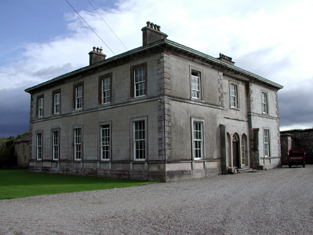
|
| Deerpark (Lismore) | Arthur Ussher held in fee a farmhouse and farmyard at Deerpark, valued at £16 10s, in 1851. Extensive farm buildings still exist at the site. | |
| Cappoquin House | in 1851 Cappoquin House was held in fee by Sir Richard Keane and valued at £56 15s.IN 1786, Wilson refers to the house at Cappoquin as Bellmont, the seat of John Kane. The 1855 sale notice describes it as a "handsome, modern and extensive building". In 1906 it was the residence of Lady Adelaide Keane and valued at over £57. Bence-Jones notes that it was burnt in 1923 but later rebuilt in the same style. The ITA survey in the early 1940s noted that the library and art collection were destroyed in the 1923 fire. It is still extant and occupied by the Keane family. The house and gardens are open to the public at certain times. |

|
| Glencairn Abbey | Glencairn was held in fee by Jervis (Gervase) P. Bushe in 1851 when it was valued at £51. The property had previously been part of a Gumbleton estate, firstly as Ballygarron Castle and later, in the eighteenth century, a house known as Castlerichard. Wilson records it under this name in 1786, describing it as "the beautiful seat of Mr. Gumbleton". Its name was changed to Glencairn Abbey c.1814 when it was substantially altered and extended by Richard Edward Gumbleton. Following his death in 1819 it passed to his brother-in-law Henry A. Bushe, in whose family it remained until the 1880s. It became a Power property following the marriage of Frances Bushe and Ambrose Power of Barrettstown, county Tipperary. It was owned by the representatives of Gervase Bushe in 1906 and valued at £31. The Powers continued to occupy Glencairn until 1922. It was purchased by the Cistercian Order in 1926 and has been home to the Cistercian Sisters since. The substantial steward's house and farmyard [X009983] is now the home of the Barry family who provide guest accommodation there. In 1906 it was also held by Bushe's representatives and valued at £12. |
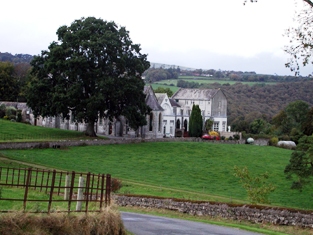
|
| Lisfinny House | Major Edward Croker was leasing this house from the Devonshire estate in 1851 when it was valued at £23. Lewis also recorded it as his residence in 1837 when he noted that "the ancient castle, built by the Earl of Desmond, has been converted into a handsome residence". It is still extant and occupied. |
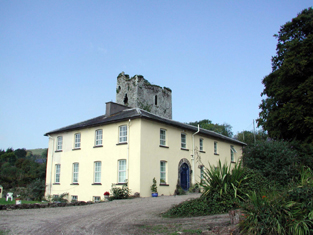
|
| Lismore Villa | Leased by the Devonshire estate to H.K. Hemming at the time of Griffith's Valuation, when it was valued at £30. It is still extant. |

|
| Mocollop Castle | Mocollop Castle was in ruins by the time of Griffith's Valuation, though buildings at the site were valued at £31. They were held in fee by Captain James Barry. In 1786, Wilson refers to it as the seat of Dr. Drew. In 1906 the buildings at this location were in the possession of Henry Drew, MD, and valued at £32. The National Inventory of Architectural Heritage reports that the buildings there were in ruins in the early part of the 21st century. |

|
| Bellevue (Lismore) | Paul Shewcraft was leasing this property from the Devonshire estate in 1851 when it was valued at £19 10s. | |
| Rath House | In 1851 John Carroll was leasing this property from the Devonshire estate when it was valued at £16. Labelled as Rath House on the later 25-inch Ordnance Survey Map. | |
| Lismore Townparks West | In 1851 William Baldwin was leasing this property from the Devonshire estate when it was valued at £11. | |
| Salterbridge House | The current Salterbridge House was mainly constructed in 1849 but incoroporated an eighteenth century house. Wilson, writing in 1786, refers to "Salta Bridge" as the seat of Richard Musgrave, "remarkable for its extensive orchards". At the time of Griffith's Valuation it was the residence of Richard Chearnley and valued at £68. In 1906 Salterbridge was owned by Henry P Chearnley and valued at over £70. The house remained in the family until the 1950s and subsequently became part of the Wingfield estate. It is still extant and open to the public at certain times. An associated gate-lodge is available for self-catering accommodation through the Irish Landmark Trust. See www.irishlandmark.com. |

|
| Castle Farm | IN 1851 the farmhouse at Castlelands was held in fee by the Devonshire estate and valued at £27. The farm house is still extant and occupied. A large farmyard complex was located at X035986. In 1906 the buildings at this location had a valuation of £15 10s. |

|
| Drumroe House (Waterford) | In 1851 this property was leased by Sir W.J. Homan from the estate of Mansergh St. George, when it was valued at £45. William Jackson Homan was a member of the Homan family of county Westmeath and married to Lady Charlotte Stuart. Local sources suggest he acted as a steward on the Dromana estate. The house is now a ruin. | |
| Glenbeg House (Lismore) | In 1851 Glenbeg House was owned by Thomas Foley but was vacant. It was valued at £23 10s at that time. In 1837 Lewis refers to it as the seat of G. Bennett Jackson. The original house dates from the mid-sveenteenth century though it was renovated in the nineteenth and twentieth centuries. Smith, writing in 1774, refers to it as the seat of Mr. John Jackson. Sadleir, referring to Rowland Jackson in 1775, notes that he was "of Glanbeg". Brady notes that the Jacksons were employed by the first Earl of Cork in the early seventeenth century. Described as "an ordinary farmhouse" in the ITA Survey in 1942. It is still extant and occupied. |

|
| Kilbree House | At the time of Griffith's Valuation, Phillip Chearnley was leasing this property from Matthew Whelan when it was valued at £28. There is still an extant house at this site. Another property in this townland is referred to in ITA Survey of the 1940s as Kilbree Castle. This building, described as "in ruins" on the 25-inch Ordnance Sirvey map of the 1890s, had been reconstructed and was occupied at the time of the survey by Gerald Stuart. In 1786 Wilson mentions that Kilbree had "formerly belonged to the Knights Templars". Buildings are still extant at the site. | |
| Tubbrid (Lismore) | In 1851 this property was held in fee by Townsend Keily and valued at £23 10s. The property is still extant and part of a large farming enterprise. | |
| Kilmore House (Tallow) | Held in fee by Rev. William Percival at the time of Griffith's Valuation, when it was valued at £37. Lewis refers to it in 1837 as "Kilmore Hill, residence of Rev. W. Percival, a handsome seat on the new line of road to Youghal". Wilson, writing in 1786, refers to the Perceval residence near Tallow as "Kilmahoe". In 1906 it was still owned by William Percival and valued at £37 10s. |
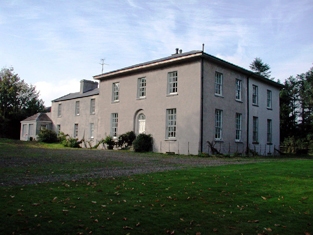
|
| Roseville (Tallow) | Leased by William Parker from the Devonshire estate at the time of Griffith's Valuation when the buildings were valued at £20 10s. It is also recorded as his address in the 1870s. Roseville is still extant and occupied. |

|
| Tivoli (Cappoquin) | Tivoli was being leased by Henry Dennehy from the Keane estate at the time of Griffith's Valuation, when it was valued at £17. It was included in the sale of Dennehy's estate in the Encumbered Estates Court in 1857 when it was in the owner's possession. The house is still extant and occupied. |

|
| Mayfield (Lismore) | The sale notice concerning the property of Robert Dring O'Grady in the barony of Coshmore and Coshbride, county Waterford, includes details of the house built on the property by Captain O'Grady in the 1850s. It was "of modern construction" and had cost over £1200. |
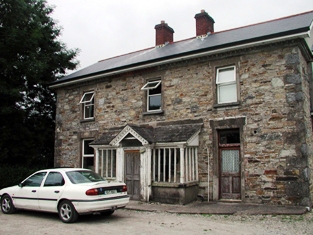
|
| Ballingowan House (South) | Robert Dower was leasing this property from William Villiers-Stuart at the time of Griffith's Valuation, when it was valued at £13 5s. A house still exists at this site. | |
| Bleach | At the time of Griffith's Valuation, Charles Graves was leasing property from the Villiers-Stuart estate which included a house and mill. The complex was valued at over £37. By the later nineteenth century Bleach House is shown here but the mill in not shown. A house is still extant at the site. | |
| Villierstown House | In 1851 leased by Rev. Hans Butler from the Villiers Stuart estate when it was valued at £14 5s. Still extant and occupied. |

|
| Affane House | Held in fee by Samuel Browning Power in 1851 when it was valued at £32. Lewis refers to it as the seat of S. Power in 1837. It was the property of Samuel J. Power in 1906 and still valued at £32. Brady notes that the house incorporates material from the late seventeenth century house owned by the Greatrakes famly. In the 1780s Taylor and Skinner refer to it as a residence of the Browning family. It is now almost a ruin. |

|
| Richmond House (Affane) | Maj John H. Alcock was leasing this property from Henry Dennehy at the time of Griffith's Valuation when it was valued at £29. Lewis also noted it as his seat in 1837. The National Inventory of Architectural Heritage indicates it was also linked with the Villiers Stuart family. It is still extant and occupied. |

|
| Dromana | The seat of the Villiers-Stuart family, Lord Stuart de Decies, and held in fee by them in 1851 when it was valued at £101. In 1837 Lewis had noted that "its hanging gardens presents a picturesque and interesting feature". Charles Smith, referring to it as a noble seat of the Earl of Grandison, provides a detailed description of how it looked in the later eighteenth century. An account of its appearance in the 1940s is given in the Irish Tourist Association files. The National Inventory of Architectural Heritage indicates it is a seventeenth century house possibly incorporating parts of a medieval tower house. It was later extended and renovated but this Georgian extension was demolished in the 1960s leaving the original seventeenth century building. It is occasionally open to the public. |
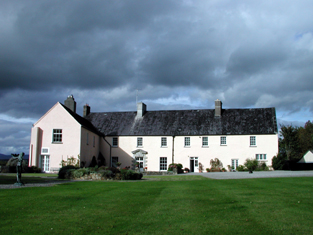
|
| Derriheen House | In 1851 Mrs. Grace Mansfield was occupying this property, which was in the hands of the Court of Chancery at the time. It was valued at £24. It is still extant and occupied. Lewis refers to it in 1837 as the seat of C. Maunsell. |
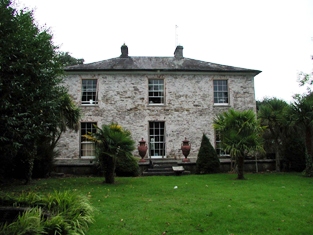
|
| Monyvroe | In 1851 Edmund Power held this property from Lord Decies estate when it was valued at £11 10s. There are still extant buildings at the site. | |
| Mountrivers (Affane) | In 1851, Sir Charles Shaw was leasing this property from the Gumbleton estate when it was valued at £27. The Villiers Stuart Papers in PRONI suggest Shaw was the head agent for that estate from the late 1840s.Lewis refers to it as the seat of Rev. G. Gumbleton in 1837. Mountrivers was demolished in the 1990s. A nearby property [X104975]. valued at £15, was held by Shaw from the Musgrave estate and used as a fever hospital. |

|
| Littlebridge | In 1786, Wilson refers to Littlebridge as the seat of Andrew English. By the time of Griffith's Valuation, this area was part of the estate of Sir Richard Keane. | |
| Castle Lyons | Wilson, writing in 176, refers to the accidental burning of the seat of the Earls of Barrymore. "The mansion house, with the furniture and a valuable collection of pictures, were entirely destroyed by an accidental fire". Some ruins remain at the site. A dower house, built by the Barry family towards the end of the 18th century, is still extant and known as Berryhill. . |

